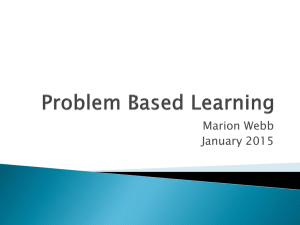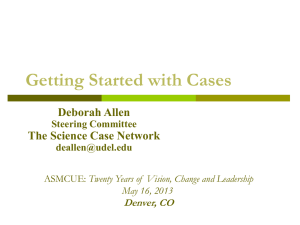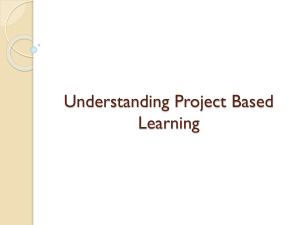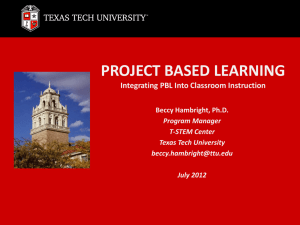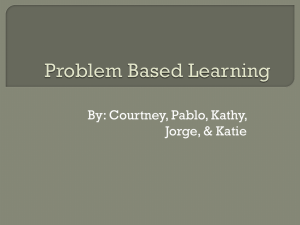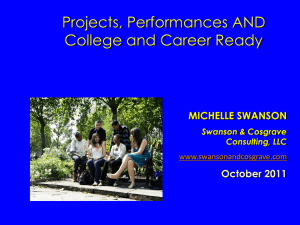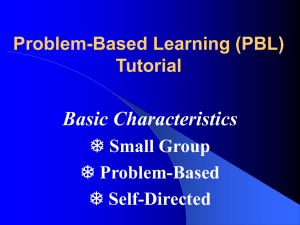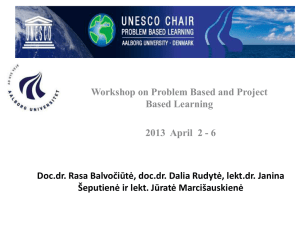Session 2_LSBU - Keele University
advertisement
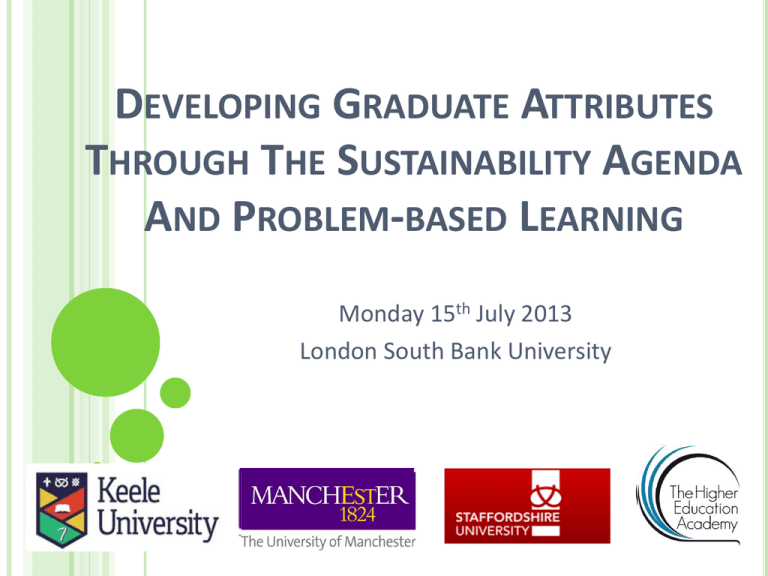
DEVELOPING GRADUATE ATTRIBUTES THROUGH THE SUSTAINABILITY AGENDA AND PROBLEM-BASED LEARNING Monday 15th July 2013 London South Bank University PROBLEM-BASED LEARNING IN A CHANGING HIGHER EDUCATION ENVIRONMENT Zoe Robinson Keele University INTRODUCING TRADITIONAL vs ‘HYBRID’ PROBLEM-BASED LEARNING The ‘traditional’ PBL format Tutors do not deliver content through lectures Tutors become ‘facilitators’ of group learning Tutors are learning enablers rather than knowledge givers “This module is more practical and so more useful than other modules. Sitting in lectures you forget the information and only a few points stick in your mind. You remember more from this module. In this course we faced real problems, when you solve a problem you never forget how you solved the problem” The ‘traditional’ PBL format (2) Groups of ~8-10 students Each group has a trained facilitator (not necessarily a subject specialist) Given problem/scenario/project brief – describing and outlining the problem ‘Wicked’ problems – open-ended, complex frameworks based around a specific topic Regular meetings 1 or 2 a week with facilitator May be assessed by exam The ‘traditional’ PBL process 1) Highlight and clarify unfamiliar terms and concepts 2) Define the nature of the problems and issues for exploration 3) Analyse and brainstorm the scenario by sharing group knowledge and experience 4) Formulate learning objectives for further research 5) Between group sessions self-directed learning based on the agreed learning objectives 6) Subsequent group sessions – sharing of private study Student roles – chair, scribe Facilitator adds information, ensures group process is effective Example from medical education Scenario based around a patient expressing the symptoms of appendicitis Narrative background information about the patient Narrative revealed bit-by-bit, discussion after each section Agree learning objectives Research – all students cover all learning objectives Background to disease Other possible explanations for the symptoms How to proceed with diagnosis and treatment Discussion of research reinforces learning Process analogous to real practice Assessed by exam The role of the facilitator Facilitate group process and PBL learning environment Monitor attendance Monitor and steer student discussions Has background information and is familiar with the case study Add guidance and data as need is identified but not definitive answers Steers towards learning objectives if key areas are being missed Any experiences of delivering through PBL? What were the positives? Negatives? So what is ‘Hybrid’ PBL? Based on the principles of PBL but adapted from the traditional model Adaptations made to overcome resource and time constraints of traditional PBL Makes PBL more accessible and feasible for larger student cohorts in resource-constrained times How does ‘Hybrid’ and traditional PBL compare? Similarities Student-driven group learning Investigate openended (‘wicked’) problems Students define learning objectives Self-directed research Some facilitation Differences Smaller groups A mixture of classroom approaches Less facilitator time Online facilitation Online learning materials Online student communication Online student collaboration Now to an example…. Innovative assessments Greening Business-Keele University • The module: – 15 credits, 12 weeks – Mixed-subject cohort – Groups of 4 • Different pbl briefs around improving University’s sustainability performance • Research • • • • Relevant sustainability issues Best practice Current institutional practice Justified recommendations How? -‘Content’ delivered by podcast -In-class group discussions -Trial PBL scenario -7-week assessed PBL project Assessment -Group 5 min video summarising findings and recommendations -Presented in front of University managers -Individual reflective diary EXAMPLE SCENARIOS Have a look through a variety of scenarios on your tables. How easy do you think it will be for students to grasp the idea of PBL? How much facilitation do you think they will need? Comments? Thoughts? Developing Graduate Attributes through PBL So what are Graduate Attributes? “The qualities, skills and understandings a university community agrees its students should develop during their time with the institution. These attributes include but go beyond the disciplinary expertise or technical knowledge that has traditionally formed the core of most university courses. They are qualities that also prepare graduates as agents of social good in an unknown future.” Bowden et al., 2000, p1 (my bold) What different themes are covered in your institutions Graduate Attributes? Key areas…. Discipline Expertise Professionalism Reflective, Critical and Lifelong Learning Global Citizenship/ Perspectives Interdisciplinarity Problem solving Communication and Teamwork Flexibility Technological literacy…. Self-awareness Delivering Education for Sustainable Development (ESD) through PBL “It is worth noting that (the destruction of the planet) is not the work of ignorant people. Rather it is largely the results of work by people with BAs, BScs, LLBs, MBAs, and PhDs …Education can equip people to be more effective vandals of the earth. If one listens carefully, it may even be possible to hear the Creation groan every year in late May when another batch of smart, degree-holding, but ecologically illiterate, Homo sapiens who are eager to succeed are launched into the biosphere”. – David Orr, 1994 Sustainability is not just about recycling…. ….or the environment SUSTAINABLE Sustainable Development is development that: ‘meets the needs of the present without compromising the ability of future generations to meet their own needs’ (WCED, 1987) Economic prosperity Environmental quality Social justice ESD/EfS is transformative learning • ESD/EfS generates shifts in the perspectives and frames of reference of learners, as well as their beliefs, attitudes and reactions • The potential to create ‘change agents’ “If you make every university graduate 10 per cent more sustainable, however you measure it, that’s more impact than if you switch off all the lights in every university for a year” Iain Patton, Chief Executive, EAUC International drivers for ESD 1992: UN Conference on Environment and Development, Rio. Education seen as ‘critical for promoting sustainable development and improving the capacity of people to address environmental and development issues.’ 2005-2014 UN Decade for Education for Sustainable Development National drivers… “Within the next 10 years, the higher education sector in this country will be recognised as a major contributor to society's efforts to achieve sustainability - through the skills and knowledge that its graduates learn and put into practice, its research and exchange of knowledge through business, community and public policy engagement, and through its own strategies and operations.” (HEFCE 2009/03) “…The greatest contribution education has to make to sustainable development is by enabling students to develop new skills and knowledge. The main (though not only) way to make this happen is through developments in curricula and pedagogy.” (HEFCE, 2005) The student demand Students see skills for SD as significant for employability and their future employers A growing numbers of students are seeking both universities and employers who incorporate and reflect Many reports supporting: employer demand for good sustainability ‘sustainability-literate’ practices graduates Highlights the need for HEIs to provide UGs with the opportunities to develop these Universities and the green economy: graduates for the future Links being made between graduate attributes and the ‘Green Economy’ “Universities should enable students to develop the skills to work with the problems and uncertainty around them…” SO, WHY USE PROBLEMBASED LEARNING FOR SUSTAINABILITY EDUCATION? Effective ESD requires pedagogical shifts from: Teacher-centred to student centred Individual learning to collaborative learning Theory dominated learning to praxis-orientated learning Sheer knowledge accumulation to problem solving Emphasis on cognitive objectives to skills-related objectives (after Wals and jickling, 2002) “The nature of ESD demands new perspectives on matters like curriculum, teaching and learning. ESD and SD tend to focus on connections, feedback loops, relationships and interaction. Yet the dominant educational structures are based on fragmentation rather than connections and synergy” Wals, 2009, p64 ….AND HOW DO STUDENTS BENEFIT FROM THIS PBL, GRADUATE ATTRIBUTES, ESD AND A LOAD OF OTHER AGENDAS….? Employability and professionalism Active learning and problem solving Team working Project management Leadership Developing a logical and analytical approach to unfamiliar situations Employability and professionalism Critical reasoning and reflection Negotiating and persuading skills Group communication Real-world scenarios Audience focussed Approaching professionals “When we met [the energy manager] about the energy issues it was a really professional meeting and the topics we discussed were nicely in depth, really technical. In some modules it’s still like school. It’s nice to be in a work-based environment” Internationalisation Internationalised student cohorts International real-world scenarios “I really enjoyed this group….Our different cultural backgrounds and views really helped” Interdisciplinarity Work with students from different programmes Sustainability inherently interdisciplinary Peer-learning “People on different courses all had different views on the issues, for example I took a more science-based approach to the answers, whereas people on the Environment and Sustainability course took a more legal and legislation approach. So [as] a whole my breadth of knowledge was greatly expanded” “Our group contained a good mixture of people with different backgrounds, skills and knowledge. This created a good platform for discussion and allowed us to delegate tasks during the project that people were best able to do” Transformative education Learning to consider life through a ‘sustainability lens’ – appreciating the environmental, social and economic implications of our decisions and life choices “One of my biggest fears is that you go through the education system and you learn information but you never put it into the context of business. I wasn’t interested in sustainability at all before starting and suddenly, now I love it. It’s a case of I can see myself doing sustainability within a job and see myself going into a company and suddenly being able to put all my skills into practice and then implementing sustainability within that business” “I didn’t believe as an individual I could make a difference but now I know that I can” Lifelong learning Becoming active rather than passive learners Students define what they need to research Learning HOW to learn “I think I am better at solving problems and creating solutions. I have further developed my ability to research a topic by identifying what is relevant and the ways in which to find information”” Summary Enable students to be more effective in their future career: Working collaboratively with a diverse range of people Tackling projects where they have no prior knowledge Handling complexity and uncertainty Rigorous approach to researching, critically, analysing information sources Learn how to learn independently Thank you! Questions?

